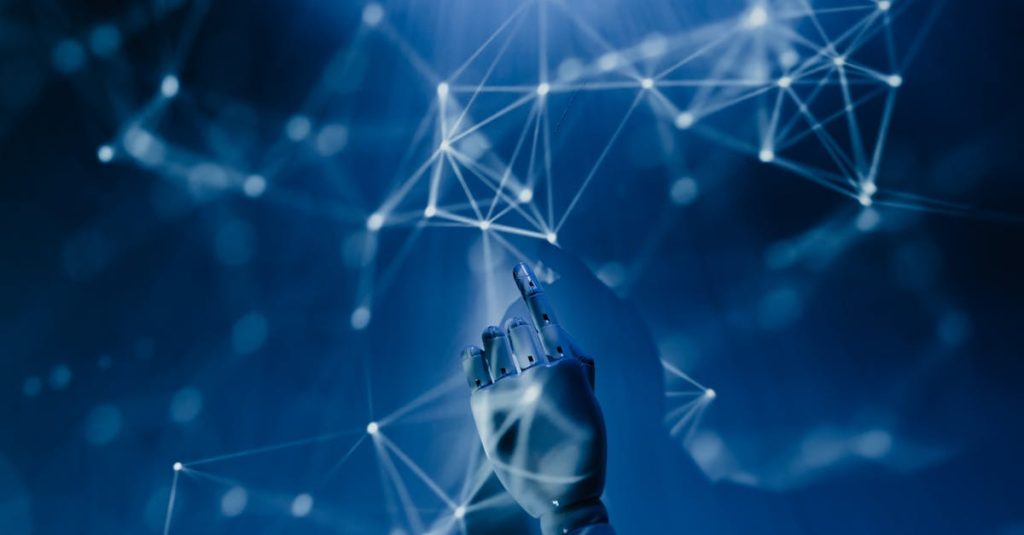Artificial intelligence is redefining how music is composed, produced, and monetized, but it is not sidelining human artists. Today’s global AI-powered music market is projected to exceed one billion dollars by 2028, highlighting both economic disruption and new creative horizons. This article examines how AI tools are transforming workflows, shifts in musician roles and revenue, evolving human–AI collaboration, legal and ethical questions, future industry trends, and practical benefits for creators using platforms like Mureka’s AI Music Generator and Editor. Readers will gain insights into core technologies, economic realities, creative partnerships, rights challenges, adaptation strategies, and concrete opportunities for independence and growth in an AI-enhanced music landscape.
How Is AI Transforming Music Creation and Production?
AI-driven composition uses machine learning algorithms and neural networks to generate melodies, chords, and rhythms without human intervention. Generative models analyze millions of musical patterns to propose new instrumental arrangements, enabling rapid prototyping across genres. These systems learn stylistic features—from classical counterpoint to electronic dance beats—and apply them to fresh compositions, reducing initial sketch times from days to minutes. As a result, producers and hobbyists can iterate more quickly, focus on artistic direction, and explore uncharted sonic combinations.
By offering an interactive editor overlay, Mureka’s AI Music Generator and Editor allows users to refine AI-drafted tracks with human supervision. After an AI draft emerges, creators can adjust tempo, instrumentation, and tonal balance in real time, preserving artistic intent. This human-in-the-loop approach balances algorithmic speed with curated expression, ensuring each track retains unique character. The result is customizable instrumental music that feels both innovative and authentic.
What Technologies Enable AI Music Generation?
Neural network architectures such as recurrent networks and transformer models underpin modern music generation by identifying temporal patterns in audio data. These systems use unsupervised learning on large datasets of MIDI files and stems to detect harmonic sequences, melodic contours, and rhythmic motifs. Signal processing techniques then convert symbolic outputs into high-fidelity audio, creating instrumental tracks ready for mixing.
How Does Mureka’s AI Music Generator Work Across Genres?
Mureka’s platform integrates generative AI models trained on diverse genre corpora—from cinematic orchestration to lo-fi hip-hop—allowing seamless style switching. Users select mood presets (uplifting, ambient, driving) and adjust complexity sliders, triggering genre-specific neural modules. Each module applies learned patterns to instrument layers, producing cohesive arrangements in seconds.
Can AI Create Original and Customizable Instrumental Music?
Yes, AI can craft fully original instrumental pieces that composers can personalize. By tweaking style parameters and editing motifs through the AI Music Editor, creators shape melodies, harmonies, and textures. This degree of customization empowers both professionals and novices to produce royalty-free tracks tailored to video, podcasts, or album projects without licensing hassles.
What Are the Economic Effects of AI on Musicians and the Music Industry?

AI adoption is shifting musician roles from traditional composition and performance to roles in prompt engineering, AI curation, and editorial oversight. While some routine composing tasks become automated, new opportunities arise in AI model tuning, sample library creation, and soundtrack customization. Musicians who master AI tools gain a competitive edge by offering rapid turnarounds and tailored services to content producers.
AI-generated music licensing is emerging as a significant revenue stream. Independent artists can monetize AI-crafted cues by offering subscription-based libraries or one-off licenses for digital media. Automated royalty tracking and distribution platforms handle usage reporting, enabling scalable income without large label backing. Moreover, reduced production expenses—by up to 70 percent in some cases—allow artists to reinvest savings into marketing and live performance.
Introduction of AI tools levels the playing field for independent creators, enabling budget-constrained musicians to compete with major studios. Affordable AI suites replace expensive studio time, mixing engineers, and session players. This democratization expands market access, empowering bedroom producers to sell original compositions globally and collaborate remotely with filmmakers, game developers, and advertisers.
| Revenue Stream | Description | Opportunity |
|---|---|---|
| AI Licensing | Subscription or per-track licensing of AI-generated cues | Recurring monthly income from content libraries |
| Editorial Services | Human-in-the-loop refinement and mastering | Premium fees for bespoke track editing |
| Custom Soundtracks | On-demand AI soundtracks for media projects | New clientele in video, gaming, and advertising |
| Production Cost Savings | Automated mixing, mastering, and composition | Reinvestment into promotion and touring |
These evolving economic models illustrate how AI influences artist income and industry structure. Understanding these shifts prepares musicians to leverage new revenue channels rather than view automation as purely disruptive.
How Is Human Creativity Evolving with AI Music Collaboration?

AI serves as a creative co-pilot, offering musical suggestions that spark fresh ideas when composers face blocks. By generating motif variations and harmonic progressions on demand, AI augments human imagination, leading to hybrid compositions that blend algorithmic novelty with personal expression. This synergy fosters experimentation across unfamiliar genres, encouraging artists to transcend stylistic comfort zones.
Within Mureka’s AI Music Editor, the human editor shapes AI output by selecting preferred instrument groups, adjusting dynamic contours, and reordering sections. This workflow positions AI drafts as raw creative material, with human insight guiding final structure and emotional nuance. Editors can emphasize particular melodic lines or suppress unwanted patterns, ensuring consistency with artistic vision.
AI assistance also accelerates revision cycles, enabling creators to test multiple interpretations in minutes rather than days. By generating alternative chord progressions or rhythmic variations, AI tools increase the breadth of exploration, leading to more polished and innovative final pieces.
- Human–AI Ideation: AI proposes thematic riffs to kickstart composition.
- Editorial Refinement: Editors prune and accentuate AI-generated segments.
- Iterative Evolution: Continuous AI-assisted tweaks refine mood and style.
This collaborative loop elevates artistic output by combining computational power with human taste, guiding us to consider the ethical frameworks that underpin creative partnerships.
What Are the Legal and Ethical Challenges of AI in Music Creation?
Ownership of AI-generated compositions remains a contested legal frontier. Under many jurisdictions, copyright law requires human authorship for protection, leaving pure AI drafts in a gray area. When a creator uses an AI Music Generator to produce an instrumental track, ownership often defaults to the human who directed and refined the process. Clear records of human edits and prompt inputs strengthen claims to authorship.
Intellectual property rights for AI training datasets pose additional concerns. Training AI on copyrighted works without explicit licenses may infringe on underlying owners’ rights. Ethical AI music platforms ensure compliance by sourcing royalty-free samples or securing blanket clearances for training corpora, protecting both creators and original rights holders.
Fair compensation and transparency demand that artists whose works contributed to AI model training receive appropriate recognition or remuneration. Some platforms explore revenue-sharing models or token-based attribution systems to reward source artists. Transparent labeling of AI contributions in credits and metadata helps maintain trust and accountability.
| Challenge | Aspect | Consideration |
|---|---|---|
| Copyright Ownership | Human vs. AI authorship | Documentation of human edits establishes rights |
| Training Data Legality | Source material licensing | Use of public domain or licensed samples |
| Fair Compensation | Royalties and attribution | Revenue-sharing or credit tokenization |
| Transparency | Metadata and labeling | Clear disclosure of AI usage in liner notes |
Navigating these legal and ethical dimensions safeguards creator interests and fosters responsible innovation within the evolving music ecosystem.
What Does the Future Hold for Musicians in an AI-Powered Industry?
Musicians who embrace AI will find their skill sets expanding into areas like prompt engineering, AI model customization, and data-driven sound design. Formal training programs and online courses are emerging to teach these competencies, blending music theory with machine learning fundamentals. Artists can boost marketability by offering hybrid expertise in both musical craft and AI technology.
Industry trends point toward deeper integration of AI across live performance, interactive installations, and real-time remixing. Virtual concert experiences may use AI to adapt visuals and soundscapes to audience reactions, creating immersive shows. Investment in AI music startups continues to grow, signaling robust support for innovative tools that streamline production and distribution.
To thrive amid these changes, artists can adopt strategies such as focusing on niche styles, building direct-to-fan communities, and offering bespoke AI-enhanced services. Emphasizing unique performance skills—live vocals, improvisation, instrumental virtuosity—ensures that human artistry remains at the core of the music experience.
| Skill Area | Development Approach | Impact on Career |
|---|---|---|
| Prompt Engineering | Workshops on AI model workflows | Faster creative ideation and customization |
| AI-Assisted Mixing | Tutorials on AI mastering tools | Consistent, high-quality final productions |
| Data-Driven Composition | Courses on generative model parameter tuning | Innovative sound design and competitive edge |
Anticipating these shifts positions musicians to lead the creative frontier, turning AI from perceived threat into opportunity.
How Can Musicians and Creators Benefit from AI Music Platforms Like Mureka?
Success stories demonstrate the positive impact of AI partnerships on careers. An independent composer increased soundtrack output by 60 percent using Mureka’s AI Music Generator, landing roles in three new indie films. A content creator doubled podcast engagement by customizing AI-created theme music to match brand identity, showcasing efficient instrumental scoring without hiring session musicians.
Mureka empowers users with fine-grained creative control through its editor interface. By adjusting individual instrument volumes, swapping samples, and rearranging sections, artists preserve personal style while benefiting from algorithmic suggestions. This blend of automation and oversight streamlines workflows and accelerates project delivery.
Economic opportunities unlocked by AI include offering rapid turnaround packages, licensing AI-driven libraries, and providing on-demand customization services to digital marketers and video producers. Lower production costs translate to competitive pricing, expanding client bases and revenue potential for independent musicians.
- Track Volume Expansion: Generate multiple variations for diverse media uses.
- Custom Scoring Services: Offer tailored instrumental cues with quick delivery.
- Library Subscriptions: Monetize AI-generated catalogs through subscription models.
These practical benefits illustrate how AI platforms like Mureka serve as creative partners rather than replacements, driving new income streams and artistic innovation.
What Are Common Questions About AI Replacing Musicians and Its Economic Impact?
Will AI Fully Replace Human Musicians in the Future?

No, AI is more likely to augment than replace musicians by handling repetitive tasks and offering generative ideas while human artists retain creative direction, expression, and performance roles.
How Does AI Affect Music Industry Jobs and Income?
AI reallocates roles toward AI model tuning, editorial oversight, and custom scoring, creating new specialized jobs even as it streamlines traditional composing and mixing tasks, ultimately expanding income opportunities through licensing and service offerings.
Can AI Music Be Truly Original and Copyrightable?
Yes, when a human guides AI outputs through prompts and edits, the resulting work qualifies for copyright protection, provided sufficient human authorship is documented and training data sources comply with licensing requirements.
What Are the Benefits and Drawbacks of AI Music for Musicians?
Benefits include accelerated workflows, cost reductions, and new revenue models; drawbacks involve ethical considerations around training data, potential devaluation of traditional skills, and the need for updated legal frameworks to protect artist rights.
Innovative AI tools are reshaping music creation without displacing the human spirit at music’s core. By blending algorithmic efficiency with personal artistry, musicians can unlock new economic models, push creative boundaries, and secure lasting livelihoods in an AI-enhanced industry. Platforms like Mureka’s AI Music Generator and Editor illustrate how technology and human vision together compose the soundtrack of tomorrow.



